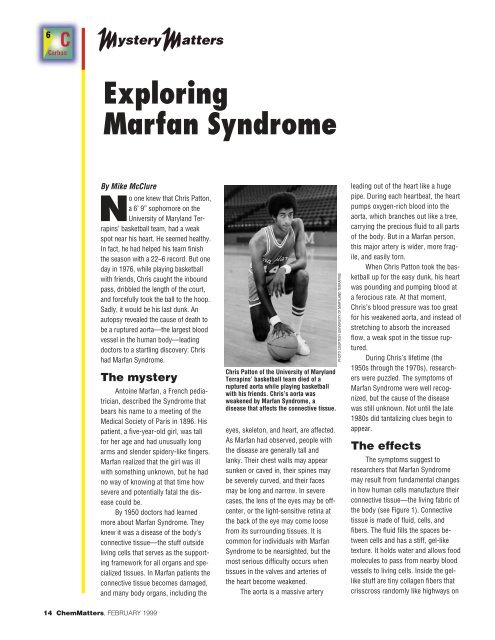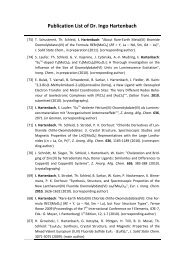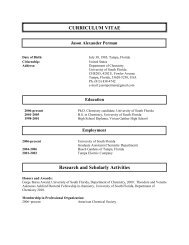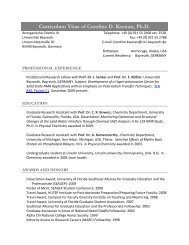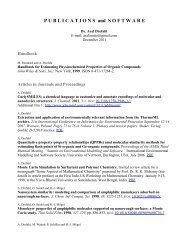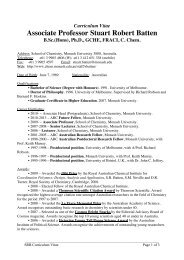Sports Drinks: Don't Sweat the Small Stuff - American Chemical ...
Sports Drinks: Don't Sweat the Small Stuff - American Chemical ...
Sports Drinks: Don't Sweat the Small Stuff - American Chemical ...
You also want an ePaper? Increase the reach of your titles
YUMPU automatically turns print PDFs into web optimized ePapers that Google loves.
MysteryMatters 14 ChemMatters, FEBRUARY 1999<br />
Exploring<br />
Marfan Syndrome<br />
By Mike McClure<br />
No one knew that Chris Patton,<br />
a 6’ 9” sophomore on <strong>the</strong><br />
University of Maryland Terrapins’<br />
basketball team, had a weak<br />
spot near his heart. He seemed healthy.<br />
In fact, he had helped his team finish<br />
<strong>the</strong> season with a 22–6 record. But one<br />
day in 1976, while playing basketball<br />
with friends, Chris caught <strong>the</strong> inbound<br />
pass, dribbled <strong>the</strong> length of <strong>the</strong> court,<br />
and forcefully took <strong>the</strong> ball to <strong>the</strong> hoop.<br />
Sadly, it would be his last dunk. An<br />
autopsy revealed <strong>the</strong> cause of death to<br />
be a ruptured aorta—<strong>the</strong> largest blood<br />
vessel in <strong>the</strong> human body—leading<br />
doctors to a startling discovery: Chris<br />
had Marfan Syndrome.<br />
The mystery<br />
Antoine Marfan, a French pediatrician,<br />
described <strong>the</strong> Syndrome that<br />
bears his name to a meeting of <strong>the</strong><br />
Medical Society of Paris in 1896. His<br />
patient, a five-year-old girl, was tall<br />
for her age and had unusually long<br />
arms and slender spidery-like fingers.<br />
Marfan realized that <strong>the</strong> girl was ill<br />
with something unknown, but he had<br />
no way of knowing at that time how<br />
severe and potentially fatal <strong>the</strong> disease<br />
could be.<br />
By 1950 doctors had learned<br />
more about Marfan Syndrome. They<br />
knew it was a disease of <strong>the</strong> body’s<br />
connective tissue—<strong>the</strong> stuff outside<br />
living cells that serves as <strong>the</strong> supporting<br />
framework for all organs and specialized<br />
tissues. In Marfan patients <strong>the</strong><br />
connective tissue becomes damaged,<br />
and many body organs, including <strong>the</strong><br />
Chris Patton of <strong>the</strong> University of Maryland<br />
Terrapins’ basketball team died of a<br />
ruptured aorta while playing basketball<br />
with his friends. Chris’s aorta was<br />
weakened by Marfan Syndrome, a<br />
disease that affects <strong>the</strong> connective tissue.<br />
eyes, skeleton, and heart, are affected.<br />
As Marfan had observed, people with<br />
<strong>the</strong> disease are generally tall and<br />
lanky. Their chest walls may appear<br />
sunken or caved in, <strong>the</strong>ir spines may<br />
be severely curved, and <strong>the</strong>ir faces<br />
may be long and narrow. In severe<br />
cases, <strong>the</strong> lens of <strong>the</strong> eyes may be offcenter,<br />
or <strong>the</strong> light-sensitive retina at<br />
<strong>the</strong> back of <strong>the</strong> eye may come loose<br />
from its surrounding tissues. It is<br />
common for individuals with Marfan<br />
Syndrome to be nearsighted, but <strong>the</strong><br />
most serious difficulty occurs when<br />
tissues in <strong>the</strong> valves and arteries of<br />
<strong>the</strong> heart become weakened.<br />
The aorta is a massive artery<br />
PHOTO COURTESY UNIVERSITY OF MARYLAND TERRAPINS<br />
leading out of <strong>the</strong> heart like a huge<br />
pipe. During each heartbeat, <strong>the</strong> heart<br />
pumps oxygen-rich blood into <strong>the</strong><br />
aorta, which branches out like a tree,<br />
carrying <strong>the</strong> precious fluid to all parts<br />
of <strong>the</strong> body. But in a Marfan person,<br />
this major artery is wider, more fragile,<br />
and easily torn.<br />
When Chris Patton took <strong>the</strong> basketball<br />
up for <strong>the</strong> easy dunk, his heart<br />
was pounding and pumping blood at<br />
a ferocious rate. At that moment,<br />
Chris’s blood pressure was too great<br />
for his weakened aorta, and instead of<br />
stretching to absorb <strong>the</strong> increased<br />
flow, a weak spot in <strong>the</strong> tissue ruptured.<br />
During Chris’s lifetime (<strong>the</strong><br />
1950s through <strong>the</strong> 1970s), researchers<br />
were puzzled. The symptoms of<br />
Marfan Syndrome were well recognized,<br />
but <strong>the</strong> cause of <strong>the</strong> disease<br />
was still unknown. Not until <strong>the</strong> late<br />
1980s did tantalizing clues begin to<br />
appear.<br />
The effects<br />
The symptoms suggest to<br />
researchers that Marfan Syndrome<br />
may result from fundamental changes<br />
in how human cells manufacture <strong>the</strong>ir<br />
connective tissue—<strong>the</strong> living fabric of<br />
<strong>the</strong> body (see Figure 1). Connective<br />
tissue is made of fluid, cells, and<br />
fibers. The fluid fills <strong>the</strong> spaces between<br />
cells and has a stiff, gel-like<br />
texture. It holds water and allows food<br />
molecules to pass from nearby blood<br />
vessels to living cells. Inside <strong>the</strong> gellike<br />
stuff are tiny collagen fibers that<br />
crisscross randomly like highways on


